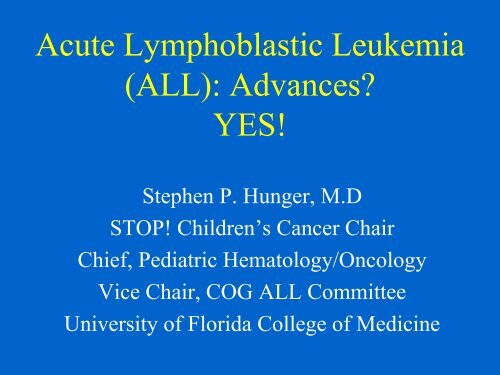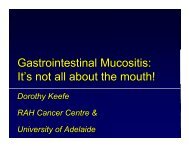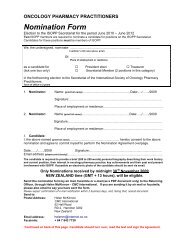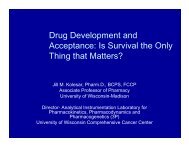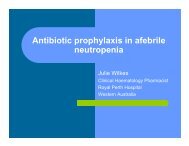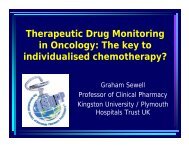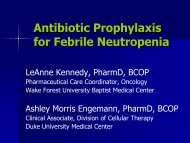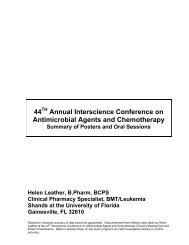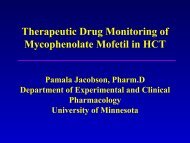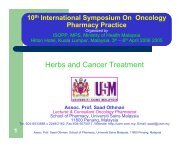Acute Lymphoblastic Leukemia (ALL): Advances? YES!
Acute Lymphoblastic Leukemia (ALL): Advances? YES!
Acute Lymphoblastic Leukemia (ALL): Advances? YES!
You also want an ePaper? Increase the reach of your titles
YUMPU automatically turns print PDFs into web optimized ePapers that Google loves.
<strong>Acute</strong> <strong>Lymphoblastic</strong> <strong>Leukemia</strong><br />
(<strong>ALL</strong>): <strong>Advances</strong>?<br />
<strong>YES</strong>!<br />
Stephen P. Hunger, M.D<br />
STOP! Children’s Cancer Chair<br />
Chief, Pediatric Hematology/Oncology<br />
Vice Chair, COG <strong>ALL</strong> Committee<br />
University of Florida College of Medicine
Outline<br />
• Overview<br />
– Childhood cancer incidence and epidemiology<br />
– <strong>Acute</strong> leukemia: epidemiology and pathobiology<br />
• Childhood <strong>ALL</strong><br />
– Classification and treatment<br />
• <strong>ALL</strong> in adolescents and young adults (AYA)<br />
• Relapsed childhood <strong>ALL</strong><br />
• The role of SCT in children and AYA with <strong>ALL</strong>
Causes of Mortality Before Age<br />
20 in the United States<br />
#1 Unintentional Injury<br />
#2 Homicide<br />
#3 Suicide<br />
#4 Cancer
Epidemiology of Cancer in<br />
Children and Young Adults<br />
• 30% of U.S. population is
Cancer Mortality: Causes Among<br />
U.S Children 0-19 Years of Age<br />
7% 6% <strong>Leukemia</strong><br />
3%<br />
35% CNS tumors<br />
7%<br />
Endocrine<br />
Other<br />
8%<br />
Soft Tissue<br />
Kidney<br />
Bone tumors<br />
9%<br />
NHL<br />
25%
<strong>Acute</strong> <strong>Leukemia</strong>s<br />
<strong>ALL</strong><br />
• 3% of all cancers<br />
– 30-35% for children<br />
• #1 cause of cancer death at ¡ 35 yrs<br />
• ~3250 cases/yr in US 0-19 yr olds<br />
– 4000-5000 <strong>ALL</strong>s/yr in US<br />
• Median age 10 years (children=adults)<br />
– 2500 <strong>ALL</strong>s/yr in US 0-19 yrs<br />
– 9000 AMLs/yr in US<br />
• Median age 65 years (adults>>children)<br />
– 650 AML/yr in US 0-19 yrs<br />
AML
<strong>Leukemia</strong> Subtypes by Age<br />
14%<br />
2%3%<br />
9% 4%<br />
<strong>ALL</strong><br />
AML<br />
CML<br />
Other<br />
36%<br />
51%<br />
81%<br />
0-5 years 15-19 years
<strong>ALL</strong>: Molecular Pathogenesis<br />
• While <strong>ALL</strong>s are morphologically similar, they are<br />
clinically and biologically heterogeneous<br />
• <strong>ALL</strong> is not caused by a single mutation but<br />
requires 2-6 mutations<br />
– Mutations almost always somatic<br />
• Initiating mutations often result from chromosome<br />
translocations<br />
– Initiating events can occur in utero
<strong>ALL</strong>: Cytogenetics<br />
• Careful analysis shows that 90% + of <strong>ALL</strong>s contain<br />
cytogenetic abnormalities<br />
– Abnormalities are acquired (somatic; not present in<br />
germline) and disappear when remission is achieved<br />
• Some cytogenetic abnormalities have important<br />
prognostic and therapeutic implications<br />
• Types of abnormalities<br />
– Numerical: Gain or loss or one or more chromosomes<br />
– Structural: Exchanges of information between<br />
(translocations) or within (inversions) chromosomes
<strong>ALL</strong>: Role of Chromosome<br />
Translocations<br />
• <strong>ALL</strong> is biologically heterogeneous<br />
• Role of chromosome translocations<br />
– Critical role in leukemogenesis<br />
– Specific recurrent abnormalities are powerful predictors of<br />
outcome and can be used for treatment stratification in riskadapted<br />
therapy<br />
– Oncogenes involved in leukemogenesis play a critical role<br />
in normal hematopoiesis<br />
– Identify targets and pathways for rationally-designed<br />
therapeutic interventions
Common Targets of<br />
Translocations in <strong>Leukemia</strong><br />
Gene Location #Partners<br />
E2A 19p13.3 3 cloned<br />
MLL (HRX) 11q23 30+, 18 cloned<br />
CBFα or β 21q22/16p13 5 cloned<br />
TEL (ETV6) 12p13 9+ cloned<br />
RARα 17q21 4 cloned
Molecularly-Targeted Therapy: Imatinib<br />
in Chronic Myelogenous <strong>Leukemia</strong><br />
N Engl J Med 348: 994, 2003
Outline<br />
• Overview<br />
– Childhood cancer incidence and epidemiology<br />
– <strong>Acute</strong> leukemia: epidemiology and pathobiology<br />
• Childhood <strong>ALL</strong><br />
– Classification and treatment<br />
• <strong>ALL</strong> in adolescents and young adults (AYA)<br />
• Relapsed childhood <strong>ALL</strong><br />
• The role of SCT in children and AYA with <strong>ALL</strong>
Therapy of Childhood <strong>ALL</strong>:<br />
Milestones<br />
• 1948: Aminopterin induces temporary remissions in<br />
children with leukemia (Farber)<br />
– First demonstration that chemotherapy was effective for<br />
cancer<br />
• Early 1960s: First cures of childhood <strong>ALL</strong><br />
• Early 1970s: Adoption of prophylactic CNS Rx<br />
– Radiation initially; most now receive intrathecal chemotherapy<br />
• 1960s-present: Empiric optimization of chemo regimens<br />
• 1980s-present: Improved understanding of biology<br />
paves way for new era of targeted biological therapies
Estimated Survival Percentage<br />
Improved Survival in Childhood<br />
<strong>ALL</strong><br />
100<br />
80<br />
60<br />
40<br />
20<br />
0<br />
0 2 4 6 8 10 12<br />
Years From Study Entry<br />
1996-2000<br />
(n=3421)<br />
1989-1995<br />
(n=5121)<br />
1983-1988<br />
(n=3711)<br />
1978-1983<br />
(n=2984)<br />
1975-1977<br />
(n=1313)<br />
1972-1975<br />
(n=936)<br />
1970-1972<br />
(n=499)<br />
1968-1970<br />
(n=402)
Treatment of Childhood <strong>ALL</strong>:<br />
Progress Continues<br />
1<br />
0.9<br />
CCG EFS COMPARISON BY STUDY ERAS<br />
0.8<br />
PROBABILITY<br />
0.7<br />
0.6<br />
0.5<br />
0.4<br />
0.3<br />
0.2<br />
0.1<br />
3 YEAR EFS (p=.0001):<br />
1983-89 74.5%<br />
1989-95 81.4%<br />
1996-01 84.5%<br />
1983-89<br />
(N=3711)<br />
1989-95<br />
(N=5121)<br />
1996-01<br />
(N=3806)<br />
0<br />
0 1 2 3 4 5 6 7 8 9 10 11 12 13 14 15 16 17 18 19<br />
YEARS OF FOLLOW-UP
Improvements in Outcome of<br />
Children with <strong>ALL</strong>: Reasons<br />
• Critical improvements in supportive care<br />
– Transfusion support + treatment of infections<br />
• Introduction of new chemotherapy agents has played a<br />
relatively minor role<br />
• Major improvements have come through a series of<br />
empirically-designed clinical trials<br />
– Essential role of US and European cooperative groups<br />
– Importance of treatment stratification and risk-adjusted<br />
therapy
Chemotherapy Agents Used in<br />
Childhood <strong>ALL</strong>: FDA Approval<br />
• 6-Mercaptopurine 1953<br />
• Methotrexate 1953<br />
• Prednisone 1955<br />
• Dexamethasone 1958<br />
• Cyclophosphamide 1959<br />
• Vincristine 1964<br />
• Cytosine Arabinoside 1969<br />
• L’Asparaginase 1978<br />
• Daunorubicin 1979
Key Components of Successful <strong>ALL</strong><br />
Therapy<br />
• Empiric multi-agent<br />
chemotherapy<br />
• Pre-symptomatic CNS<br />
therapy<br />
• Risk adapted therapy<br />
• Post-induction<br />
intensification
Prevention of CNS <strong>Leukemia</strong><br />
Dramatically Improves <strong>ALL</strong> Outcome<br />
• 1960s: induced remissions in most<br />
patients but very high rate of early<br />
CNS relapses<br />
– 50-75% had CNS relapse within 6-12<br />
months<br />
• Most chemo agents have poor CNS<br />
penetration and prophylactic CNS<br />
treatment is essential<br />
– Dramatic increase in cure rates in early<br />
70s with universal use of craniospinal<br />
irradiation<br />
– Most patients now receive intensive<br />
intrathecal chemo rather than<br />
irradiation<br />
CSF cytospin<br />
Lymphoblast in CSF
Risk Group Stratification and<br />
Risk-Adjusted Therapy<br />
• Patients are grouped to select proper treatment strategy<br />
– High risk patients fare poorly when treated with less intensive<br />
regimens appropriate for standard risk patients but do much<br />
better with more intensive therapy<br />
– Data based on groups, but therapy is applied to individuals<br />
• Risk group definitions<br />
– NCI/Rome criteria based on age and initial WBC<br />
– New COG criteria include genetic features and early<br />
treatment response
Clinical Risk Groups in Childhood B-<br />
Precursor <strong>ALL</strong>: NCI/Rome Criteria<br />
• Standard risk (~65% patients with EFS ~80%)<br />
– Age 1.00-9.99 years<br />
– Initial white blood count
Biological Features Refine<br />
• Immunophenotype<br />
Clinical Risk Groups<br />
– T-<strong>ALL</strong> patients fare relatively poorly when treated with low<br />
intensity therapy but do well when treated more intensively<br />
– Mature B-<strong>ALL</strong> (Burkitt’s) treated very differently<br />
• Ploidy<br />
– Hyperdiploid DNA index (DI >1.16) = favorable<br />
• Best group defined by “triple trisomies” (+4, +10, +17)<br />
– Hypodiploid (
Genetic Heterogeneity in<br />
Childhood <strong>ALL</strong><br />
11q23<br />
4%<br />
TEL-AML1<br />
18%<br />
14q11<br />
3%<br />
Ph<br />
2%<br />
t(1;19)<br />
4%<br />
“Normal”<br />
26%<br />
< 45 Chrom<br />
1%<br />
45 Chrom<br />
3%<br />
Pseudodiploid<br />
10%<br />
47-50 Chrom<br />
6%<br />
> 50 Chrom<br />
26%
Genotype and Outcome in<br />
Childhood <strong>ALL</strong><br />
100<br />
Probability<br />
80<br />
60<br />
40<br />
TEL (n =176)<br />
Trisomies 4,10,17 (n = 746)<br />
t(4;11) (n = 44)<br />
t(1;19) (n = 139)<br />
20<br />
0<br />
4 Yr EFS (%) SE (%)<br />
Tris 4,10,17 92.1 1.1<br />
TEL 89.0 3.1<br />
t(1;19) 68.9 4.1<br />
t(4;11) 49.9 11.2<br />
t(9;22) 27.5 4.4<br />
0 1 2 3 4 5 6 7 8 9 10 11 12 13 14 15 16<br />
Years Followed<br />
t(9;22) (n=132)<br />
B-precursor <strong>ALL</strong><br />
10/2001
Day 7 Marrow Response Predicts<br />
Outcome for Children with HR-<strong>ALL</strong><br />
1.00<br />
Event-Free Survival<br />
0.75<br />
0.50<br />
0.25<br />
RER<br />
IER<br />
SER<br />
d7 d14 d28<br />
M1 M1 M1<br />
M2/M3 M1 M1<br />
M2//M3 M2/M3 M1<br />
0 12 24 36 48 60 72 84<br />
Time (months)<br />
Steinherz et al: JCO 1996: 14:389-398
COG <strong>ALL</strong> Risk Groups<br />
Age, WBC<br />
Immunophenotype<br />
Trisomies<br />
Ploidy<br />
Translocations<br />
Marrow response<br />
MRD<br />
Low Risk<br />
Standard Risk<br />
High Risk<br />
Very High Risk
Outcome by New COG Risk<br />
Group Definitions<br />
Probability<br />
100<br />
80<br />
60<br />
Low Risk (n=544)<br />
High Risk (n=880)<br />
Standard Risk (n=1471)<br />
40<br />
20<br />
0<br />
Risk Group 4 Yr EFS (%) SE (%)<br />
Low 91.5% 1.6<br />
Standard 82.1% 1.4<br />
High 72.9% 2.1<br />
Very High 33.6% 6.0<br />
Very High Risk (n=78)<br />
0 1 2 3 4 5 6 7 8 9<br />
Years Followed<br />
POG ALinC 16<br />
B-precursor <strong>ALL</strong><br />
10/2001
Contemporary Therapy of Childhood<br />
<strong>ALL</strong>: General Overview<br />
• Remission induction<br />
– Remission = normal blood counts, normocellular marrow<br />
with
Risk-Adapted Therapy: Different<br />
Questions for Different Groups<br />
• Low risk (~90% cure)<br />
– Intensify modestly or reduce therapy?<br />
• Standard risk (~82% cure)<br />
– Test treatments effective in HR patients<br />
• High risk (~73% cure)<br />
– Add additional agents<br />
• Very high risk (~35% cure)<br />
– New strategies needed<br />
• Novel intensive chemo backbone<br />
• Gleevec for Ph+ <strong>ALL</strong><br />
• SCT for some patients
Day 7 Marrow Response Predicts<br />
Outcome for Children with HR-<strong>ALL</strong><br />
1.00<br />
Event-Free Survival<br />
0.75<br />
0.50<br />
0.25<br />
RER<br />
IER<br />
SER<br />
d7 d14 d28<br />
M1 M1 M1<br />
M2/M3 M1 M1<br />
M2//M3 M2/M3 M1<br />
0 12 24 36 48 60 72 84<br />
Time (months)<br />
Steinherz et al: JCO 1996: 14:389-398
Slow Early Response – Rationale<br />
for “Augmented” BFM<br />
• German efforts to improve outcome for<br />
prednisone poor responders included addition of<br />
high dose Ara-C, high dose methotrexate,<br />
ifosfamide and vindesine<br />
– No improvement in outcome in 2 consecutive trials<br />
• Since addition of new myelotoxic drugs did not<br />
improve outcome, CCG chose to intensify<br />
Vincristine and L-Asparaginase and to use IV<br />
Methotrexate without rescue
“Standard” vs. “Augmented” Therapy:<br />
Dose Intensity in First Year<br />
Standard BFM<br />
Augmented BFM<br />
VCR 15 30<br />
L-ASP 15 53<br />
CTX 3 4<br />
Ara-C Courses 6 8<br />
IV MTX 0 10
CCG 1882: Augmented BFM<br />
Therapy<br />
Induction<br />
Interim<br />
Re-induction<br />
Interim<br />
Re-induction<br />
Maint<br />
Consolidation<br />
Maint<br />
Consolidation<br />
Maint<br />
Re-consolidation<br />
I<br />
I<br />
II<br />
II<br />
Differences Between Standard and Augmented Therapy<br />
Extend consolidation from 4 to 8 weeks and add a 2 week course of<br />
VCR/L-ASP to neutropenic phase of each 4 week block<br />
Capizzi pulses replace oral 6MP/MTX for interim maintenance<br />
VCR-IV MTX without Lcv rescue-ASP<br />
Addition of a second interim maintenance and re-induction reconsolidation<br />
course
CCG-1882: Augmented Therapy Improves EFS for<br />
Patients with an SER (M3 Marrow at day 7)<br />
Probability<br />
1<br />
0.9<br />
0.8<br />
0.7<br />
0.6<br />
0.5<br />
0.4<br />
0.3<br />
0.2<br />
0.1<br />
0<br />
DATA UPDATED DEC 2004<br />
Augmented BFM (n=155)<br />
BFM (n=156)<br />
Log Rank p=.0006<br />
8-Year EFS RHR<br />
BFM 52.3%(s.d. 6.5%) 1.9<br />
Augmented BFM 70.2%(s.d. 6.7%) Baseline<br />
0 1 2 3 4 5 6 7 8 9 10 11 12<br />
Nachman et al., NEJM 338: 1663-1671, 1998<br />
Years Followed (from Randomization)
CCG-1882: Augmented Therapy Improves Survival<br />
for Patients with an SER (M3 Marrow at day 7)<br />
Probability<br />
1<br />
0.9<br />
0.8<br />
0.7<br />
0.6<br />
0.5<br />
0.4<br />
0.3<br />
0.2<br />
0.1<br />
0<br />
DATA UPDATED DEC 2004<br />
Augmented BFM (n=155)<br />
BFM (n=156)<br />
Log Rank p=.01<br />
8-Year Survival RHR<br />
BFM 63.7%(s.d. 6.1%) 1.7<br />
Augmented BFM 75.2%(s.d. 6.4%) Baseline<br />
0 1 2 3 4 5 6 7 8 9 10 11 12<br />
Years Followed (from Randomization)<br />
Nachman et al., NEJM 338: 1663-1671, 1998
CCG 1961: A Pivotal Trial for the<br />
Design of New COG <strong>ALL</strong> Studies<br />
• 2078 children with NCI HR <strong>ALL</strong> from 9/16/96-5/1/02<br />
• Tested components of augmented BFM<br />
– Randomized 1303 RER (day 7 M1/M2 marrow) patients to receive 1 of 4<br />
arms in a 2 x 2 manner<br />
• A: Standard therapy with 1 IM and 1 DI phase<br />
• B: Standard with 2 IM and 2 DI phases<br />
• C: Standard + augmented consolidation, IM and DI<br />
• D: Augmented BFM with 2 IM and DI phases<br />
• Differences between augmented BFM in 1882 and 1961<br />
– No XRT for RER patients in 1961<br />
– 1882 used native L’Asp throughout; 1961 had native in induction and PEG<br />
thereafter
CCG 1961: Results<br />
• Augmented BFM is superior to standard BFM<br />
• Augmented BFM has increased morbidity but no<br />
difference in mortality<br />
– Major morbidity is avascular necrosis of bone in<br />
patients 13+ years old<br />
• Risk can be decreased significantly by interrupted Dex<br />
• There is no benefit to longer duration of intensive<br />
therapy<br />
• Regimen C (augmented BFM with 1 IM + 1 DI) is<br />
the standard regimen for future HR-<strong>ALL</strong> trials
CCG-1961 EFS Outcome by RER Groups:<br />
Augmented Therapy Improves EFS<br />
1<br />
0.9<br />
Augmented BFM (N=647)<br />
Standard BFM (N=646)<br />
Probability<br />
0.8<br />
0.7<br />
Log rank p = .001<br />
0.6<br />
0.5<br />
5 Yr EFS RHR<br />
Augmented BFM 81.0% Baseline<br />
Standard BFM 70.2% 1.54<br />
0 1 2 3 4 5 6 7 8<br />
Years Followed<br />
Seibel NL et al Blood 102: #787, 2003
CCG-1961 EFS Outcome by RER Groups:<br />
No Benefit to Prolonged Intensification<br />
1<br />
0.9<br />
Standard Duration (N=645)<br />
Increased Duration (N=648)<br />
Probability<br />
0.8<br />
0.7<br />
0.6<br />
0.5<br />
Log rank p = .45<br />
5 Yr EFS RHR<br />
Standard Duration 76.3% Baseline<br />
Increased Duration 74.8% 1.11<br />
0 1 2 3 4 5 6 7 8<br />
Seibel NL et al Blood 102: #787, 2003<br />
Years Followed
CCG-1961 EFS Outcome by RER Groups<br />
Probability<br />
1<br />
0.9<br />
0.8<br />
0.7<br />
0.6<br />
0.5<br />
Log rank p = .01<br />
5 Yr EFS RHR<br />
SBFM/SD 71.1% Baseline<br />
ABFM/SD 81.5% .68<br />
ABFM/ID 80.7% .71<br />
SBFM/ID 69.3% 1.13<br />
SBFM/SD (N=321)<br />
ABFM/SD (N=324)<br />
ABFM/ID (N=323)<br />
SBFM/ID (N=325)<br />
0 1 2 3 4 5 6 7 8<br />
Years Followed<br />
Seibel NL et al Blood 102: #787, 2003
Outline<br />
• Overview<br />
– Childhood cancer incidence and epidemiology<br />
– <strong>Acute</strong> leukemia: epidemiology and pathobiology<br />
• Childhood <strong>ALL</strong><br />
– Classification and treatment<br />
• <strong>ALL</strong> in adolescents and young adults (AYA)<br />
• Relapsed childhood <strong>ALL</strong><br />
• The role of SCT in children and AYA with <strong>ALL</strong>
Incidence of <strong>ALL</strong> by Age:<br />
SEER 1986-1995<br />
60<br />
50<br />
40<br />
30<br />
20<br />
Cases per million<br />
10<br />
0<br />
0-4<br />
yr<br />
5-9<br />
yr<br />
10-<br />
14 yr<br />
15-<br />
19 yr<br />
20-<br />
24 yr<br />
25-<br />
29 yr<br />
30-<br />
34 yr
<strong>ALL</strong> 5-Year Survival Rates:<br />
SEER 1986-1995<br />
90<br />
80<br />
70<br />
60<br />
50<br />
40<br />
30<br />
20<br />
10<br />
0<br />
0-4<br />
yr<br />
5-9<br />
yr<br />
10-14<br />
yr<br />
15-19<br />
yr<br />
20-24<br />
yr<br />
25-29<br />
yr<br />
30-34<br />
yr<br />
5 yr Survival
AYA <strong>ALL</strong>: Reasons for<br />
Differences in Outcome<br />
• Age is a powerful predictor of outcome<br />
– UK<strong>ALL</strong> studies<br />
• Selective entry onto trials results in children receiving<br />
more “state of the art” therapy<br />
• Treatment on pediatric trials is better: CCG vs.<br />
CALGB and FR<strong>ALL</strong>E-94 vs. LALA-94 comparisons<br />
– Better therapy vs. more comprehensive and aggressive<br />
treatment approach<br />
• Parallel pediatric and adult trials will help to address this question
The Impact of Age on Outcome in<br />
<strong>ALL</strong> with Identical Therapy:<br />
UK<strong>ALL</strong> X and XA<br />
Age (n) DFS S<br />
1-9 yr (1349) 62% 81%<br />
10-14 yr (238) 49% 72%<br />
15-19 yr (200) 35% 60%<br />
20-39 yr (228) 29% 43%<br />
Proportional hazard<br />
analysis<br />
Age RR<br />
10 yr old 1<br />
20 yr old 2<br />
40 yr old 4<br />
Chessels et al: <strong>Leukemia</strong> 12: 463-473, 1998
Accrual to NCI Cooperative Group<br />
Clinical Trials: 10/97-9/98<br />
2500<br />
2000<br />
1500<br />
1855<br />
1263<br />
Patients < 20 years old:<br />
~1% of patients with CA<br />
22% of total cooperative group accrual<br />
1000<br />
997<br />
761<br />
819<br />
500<br />
413<br />
126 162<br />
0<br />
00-04 5-9 10-14 15-19 20-24 25-29 30-34 35-39<br />
Age (Years)
Enrollment in NCI Cooperative<br />
Group Protocols: 15-19 years of age<br />
Adult Groups<br />
2.8%<br />
Pediatric<br />
Groups<br />
97.2%
AYA <strong>ALL</strong> Patients: Outcome on<br />
CCG vs. CALGB Trials<br />
• CALGB 1988-98: 103 patients 16-20 years<br />
– 93% CR rate, 38% 6 yr EFS<br />
– Outcome similar to patients 21-29 yrs on same trials<br />
• CCG 1989-1995: 196 patients 16-21 years<br />
– 96% CR rate, 64% 6 yr EFS<br />
• No significant differences in characteristics<br />
between CALGB and CCG patients<br />
Stock et al: Blood 96: 467a, 2000 (abstr.)
<strong>Acute</strong> <strong>Lymphoblastic</strong> <strong>Leukemia</strong>:<br />
Disease Free Survival is Better on Pediatric Trials<br />
Stock W Sather H, Dodge RK, Bloomfield CD, Larson A, Nachman J.<br />
Blood 96: 467a, 2000.<br />
CCG-1800 Series 16-21 Year-Olds (N = 175)<br />
68+2%<br />
DFS<br />
16-20 Years (N = 103)<br />
CALGB<br />
20-29 Years (N = 123)
AYA <strong>ALL</strong>: Comparison of<br />
FR<strong>ALL</strong>E-93 and LALA-94<br />
• Adolescents 15-20 yrs. enrolled 6/93-9/94<br />
– Pediatric FR<strong>ALL</strong>E-93: 77 pts (median 15.9 yrs)<br />
– Adult LALA-94: 100 pts (median 17.9 yrs)<br />
• No other significant differences in characteristics<br />
between FR<strong>ALL</strong>E-94 and LALA-94 patients<br />
• Outcome significantly better on pediatric trial<br />
– FR<strong>ALL</strong>E-93: CR 94%, 5-year EFS 67%<br />
– LALA-94: CR 83%, 5-year EFS 41%<br />
Boissel et al, JCO 21: 774, 2003
AYA with <strong>ALL</strong>: CCG 1961<br />
• 262 AYA <strong>ALL</strong> patients entered onto CCG 1961<br />
trial for high risk <strong>ALL</strong> from 11/96 to 5/02<br />
• Overall 5 yr. EFS 68%, 5 yr. Survival 77%<br />
– Rapid responders randomized to 4 regimens<br />
• Augmented therapy: 83% 5 yr EFS<br />
• Standard therapy: 61% 5 yr EFS<br />
– Slow responders had 76% 5 yr. EFS (all received<br />
augmented therapy)<br />
– Initial WBC<br />
• Less than 50,000: 73% 5 yr. EFS<br />
• More than 50,000: 54% 5 yr. EFS<br />
Nachman et al, Blood 104: 196a, 2004 (abstr.)
CCG-1961 Augmented vs. Standard BFM<br />
EFS outcome (Age 16+ subset)<br />
Probability<br />
1<br />
0.9<br />
0.8<br />
0.7<br />
0.6<br />
0.5<br />
0.4<br />
0.3<br />
0.2<br />
0.1<br />
0<br />
AUG BFM (N=87)<br />
STD BFM (N=76)<br />
p=.11<br />
5-Yr EFS<br />
AUG BFM 83.3% (s.d.9.8%)<br />
STD BFM 60.8% (s.d.11.0%)<br />
0 1 2 3 4 5 6 7 8<br />
Years Followed
CCG 1961: Effective Therapy<br />
Negates the Impact of Older Age<br />
Age Group<br />
1 yr<br />
2-5 yr<br />
6-9 yr<br />
10-15 yr<br />
16+ yr<br />
O/E<br />
1.40<br />
0.67<br />
1.20<br />
1.06<br />
1.04<br />
4yr EFS<br />
64.2%<br />
79.3%<br />
66.9%<br />
69.5%<br />
73.6%
<strong>ALL</strong> in Adolescents and Young<br />
Adults: Conclusions<br />
• Outcome is superior for similar patients treated on<br />
pediatric trials<br />
– Difference is substantial: cure rates are 20-30% higher in<br />
absolute numbers<br />
– Therapy vs. the context in which it is delivered?<br />
• Adolescents with <strong>ALL</strong> should be treated in pediatric<br />
centers on pediatric protocols<br />
– Where would you want your teenager treated if s/he had<br />
<strong>ALL</strong>?<br />
• Therapies effective in adolescents should be tested in<br />
young adults<br />
– Dissect the benefits of the therapy vs. the system
COG A<strong>ALL</strong>0232: HR B-Precursor<br />
<strong>ALL</strong><br />
• 2 x 2 randomized trial<br />
– Induction<br />
• 14 days Dex vs. 28 days Pred (rest of trial is Dex)<br />
– Interim Maintenance<br />
• Capizzi escalating IV MTX without rescue + Asp vs. 4 courses HD<br />
MTX<br />
• Efforts to improve AYA <strong>ALL</strong> outcome<br />
– Eligibility for COG A<strong>ALL</strong>0232 increased from
Outline<br />
• Overview<br />
– Childhood cancer incidence and epidemiology<br />
– <strong>Acute</strong> leukemia: epidemiology and pathobiology<br />
• Childhood <strong>ALL</strong><br />
– Classification and treatment<br />
• <strong>ALL</strong> in adolescents and young adults (AYA)<br />
• Relapsed childhood <strong>ALL</strong><br />
• The role of SCT in children and AYA with <strong>ALL</strong>
Relapsed <strong>Leukemia</strong><br />
• Reasons for relapse are uncertain<br />
– The patient was not treated intensively enough<br />
the first time<br />
– The patient’s leukemia cells developed<br />
resistance to particular chemotherapy agents<br />
• In general, treatment must be changed or<br />
intensified after relapse
Childhood <strong>ALL</strong>: Prognostic Factors<br />
at Relapse<br />
• Site of relapse<br />
– Bone marrow worse than extramedullary<br />
• CNS, testicular, etc<br />
• Time to relapse<br />
– Earlier much worse than later<br />
• Genetic features<br />
– Relapsed T-<strong>ALL</strong> very poor outcome in some studies<br />
• No cures with chemo alone in recent matched cohort study<br />
– Relapsed Ph+ <strong>ALL</strong> has a dismal prognosis and less<br />
then 50% of patient will achieve a 2nd remission<br />
– Relapsed TEL-AML1+ <strong>ALL</strong> does relatively well<br />
• 80% vs 33% 2 year EFS in BFM REZ 90-06
<strong>ALL</strong>: Outcome Following Relapse by<br />
Site and Time in CCG 100 Series<br />
Site<br />
BM only<br />
0-17 mo.<br />
18-35 mo.<br />
36+ mo.<br />
CNS only<br />
0-17 mo.<br />
18-35 mo.<br />
36+ mos.<br />
Number<br />
642<br />
233<br />
194<br />
215<br />
220<br />
102<br />
84<br />
34<br />
6 yr EFS<br />
16%<br />
5%<br />
10%<br />
33%<br />
37%<br />
24%<br />
44%<br />
59%<br />
6 yr OS<br />
20%<br />
6%<br />
11%<br />
43%<br />
48%<br />
33%<br />
59%<br />
72%<br />
Gaynon PS et al, Cancer 82: 1387-95, 1998
CCG 1941: Marrow Relapse within<br />
12 Months of Completing Therapy<br />
• Only about 70% of<br />
patients achieved<br />
remission<br />
• Overall EFS from<br />
study entry is 15-20%<br />
• No difference based<br />
on post-induction<br />
therapies<br />
Figure 1. Probability of event-free survival after marrow<br />
relapse according to treatment received. Data from<br />
CCG-1941. Alt BMT=alternative BMT. Chemo =<br />
chemotherapy. CBMT = family donor BMT.
<strong>ALL</strong> With BM Relapse:<br />
A<strong>ALL</strong>01P2 and A<strong>ALL</strong>0433<br />
Remission Induction<br />
+/- new agent<br />
for early<br />
relapse<br />
0-35 months CR1 36+ months CR1<br />
Alternative Donor BMT<br />
Matched Sib BMT<br />
Chemotherapy
<strong>ALL</strong> with Extramedullary Relapse<br />
0-17 mos. CR1:<br />
A<strong>ALL</strong>0433<br />
18+ mos. CR1:<br />
A<strong>ALL</strong>02P2<br />
Matched Sib BMT<br />
Chemotherapy
Early Relapse <strong>ALL</strong>: Integrate New<br />
Agents with Intensive Chemotherapy<br />
• Limited benefit from treatment intensification alone<br />
• Stem cell transplant is only part of the answer<br />
– Many patients never get to transplant<br />
– Very high risk of relapse post transplant<br />
• Hypothesize that integration of newer molecularly targeted<br />
therapies into chemotherapy backbones will increase # of CR<br />
and depth of CR pre SCT<br />
• COG <strong>ALL</strong> plan<br />
– Develop an effective therapeutic backbone<br />
– Integrate promising agents into backbone and test efficacy<br />
• 4 month EFS and MRD assessment of leukemia kill
Integration of New Agents with Intensive<br />
Chemotherapy in Relapsed <strong>ALL</strong><br />
Reduction<br />
Phase<br />
Reinduction<br />
Block 1<br />
Reinduction<br />
Block 2<br />
Reinduction<br />
Block 3<br />
A<strong>ALL</strong>01P2<br />
VCR, PRED,<br />
PEG, DOX<br />
CTX, VP-16, MTX<br />
ARA-C, ASP<br />
MRD<br />
Future new agent pilot studies<br />
MRD<br />
VCR, PRED,<br />
PEG, DOX<br />
CTX, VP-16, MTX<br />
ARA-C, ASP<br />
Time<br />
MRD<br />
ADVL0423 (Epratuzumab) in 2005<br />
Correlate with 4<br />
month EFS
Outline<br />
• Overview<br />
– Childhood cancer incidence and epidemiology<br />
– <strong>Acute</strong> leukemia: epidemiology and pathobiology<br />
• Childhood <strong>ALL</strong><br />
– Classification and treatment<br />
• <strong>ALL</strong> in adolescents and young adults (AYA)<br />
• Relapsed childhood <strong>ALL</strong><br />
• The role of SCT in children and AYA with <strong>ALL</strong>
The Role of SCT in <strong>ALL</strong> in CR1<br />
• Little role for routine use of SCT in patients with<br />
<strong>ALL</strong>
SCT for Children and<br />
Adolescents with <strong>ALL</strong> in CR1<br />
• Matched sibling SCT is generally considered the<br />
therapy of choice for:<br />
– Ph+, Hypodiploidy with n
SCT for Children and Adolescents<br />
with <strong>ALL</strong> Following Relapse<br />
• Matched sib SCT indicated for <strong>ALL</strong> with 1 st<br />
marrow relapse at any time or early CNS relapse<br />
(


